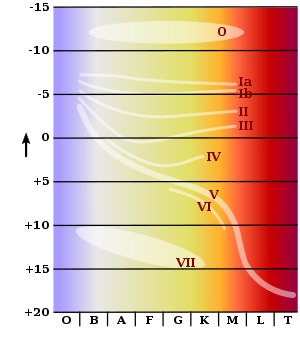Main sequence star of the spectral class O
Main sequence stars of the spectral class O (or also O stars of the luminosity class V) are the largest, hottest and also most massive (15 to 90 times solar mass) stars in the main sequence and are located in the upper left corner of the Hertzsprung-Russell diagram . Most massive stars in their initial phase belong to this star class.
properties
Stars of this type usually have a mass of about 50 solar masses . Its luminosity is 30,000 to 1 million times greater than that of the sun. Due to the higher energy, the radiation has a higher frequency and appears as blue light. These stars shine primarily in the ultraviolet range. They are physically similar to blue giants , but are smaller than them. Their surface temperatures are between 30,000 K and 52,000 K.
Since the relative proportion of massive stars is small and their lifespan is short (due to the faster internal fusion reaction with increasing mass), there are only very few stars of this type (only about one in 10 million stars; total in the Milky Way about 20,000).
O stars are very common in binary star systems . their share has been estimated to be more than 75%, whereby the discovery of a companion is made more difficult by the high luminosity of the O star and the rapid rotation of the early star. The fast rotation spreads the spectral lines through the Doppler effect and in combination with the high luminosity the spectral lines of the companion are no longer detectable. Because of the high rate of double stars, the O-stars probably arise predominantly from merging in interacting multiple systems . These massive stars are the forerunners of core collapse supernovae , part of the gamma ray bursts , millisecond pulsars, and the double neutron stars .
Subclasses
Objects are divided into the subclass O Vz based on the relation of the equivalent width of the helium lines HeII4686 / HeI4541. These stars with a relatively weak HeI4541 absorption line are on average younger and have both a lower luminosity and stellar winds . The formation of the Vz subclass could also be strongly dependent on the metallicity . If the HeII4686 line occurs in emission, the stars are classified as Of stars. These stars show strong stellar winds and tend to develop away from the main sequence.
Examples
A representative of these stars that is visible to the naked eye under suitable observation conditions is the smaller companion of the double star Almaak (γ And) in the constellation Andromeda with an apparent magnitude of about 5 mag. Further examples of O-stars of the main sequence are ζ Ophiuchi , σ Orionis A and 10 Lacertae .
| Surname | Mass in M ☉ |
Radius in R ☉ |
Luminosity in L ☉ |
|---|---|---|---|
| 10 Lacertae | 6th | 4.2 | 998 |
| σ Orionis A | 18th | 7.7 | 3300 |
| ζ Ophiuchi | 8th | 5.4 | 1630 |
Individual evidence
- ^ Tables 1 and 4, Fabrice Martins, Daniel Schaerer, and D. John Hiller: A new calibration of stellar parameters of Galactic O stars . In: Astronomy & Astrophysics . 436, 2005, pp. 1049-1065. bibcode : 2005A & A ... 436.1049M . doi : 10.1051 / 0004-6361: 20042386 .
- ^ Table 5, William D. Vacca, Catharine D. Garmany, and J. Michael Shull: The Lyman-Continuum Fluxes and Stellar Parameters of O and Early B-Type Stars . In: Astrophysical Journal . 460, April 1996, pp. 914-931. bibcode : 1996ApJ ... 460..914V . doi : 10.1086 / 177020 .
- ↑ Scientists Begin To Tease Out A Hidden Star's Secrets , ScienceDaily , July 27, 1998. Accessed on line November 13, 2007.
- ^ SJ Williams, DR Gies, TC Hillwig, MV McSwain, W. Huang: Radial Velocities of Galactic O-Type Stars. II. Single-lined Spectroscopic Binaries . In: Astrophysics. Solar and Stellar Astrophysics . 2012, arxiv : 1209.2135 .
- ^ R. Chini, A. Barr, LS Buda, T. Dembsky, H. Drass, A. Nasseri, VH Hoffmeister, K. Fuhrmann: The Multiplicity of High-Mass Stars . In: Astrophysics. Solar and Stellar Astrophysics . 2013, arxiv : 1306.1811 .
- ↑ C. Sabin Sanjulián et al .: The VLT-FLAMES Tarantula Survey. XIII: On the nature of O Vz stars in 30 Doradus . In: Astrophysics. Solar and Stellar Astrophysics . 2013, arxiv : 1312.3278v1 .
- ↑ BR Online Stargazer
- ↑ BD-02 1326A , SIMBAD query result. Accessed on line November 13, 2007.
- ↑ 10 Lac , SIMBAD query result. Accessed on line November 13, 2007.
